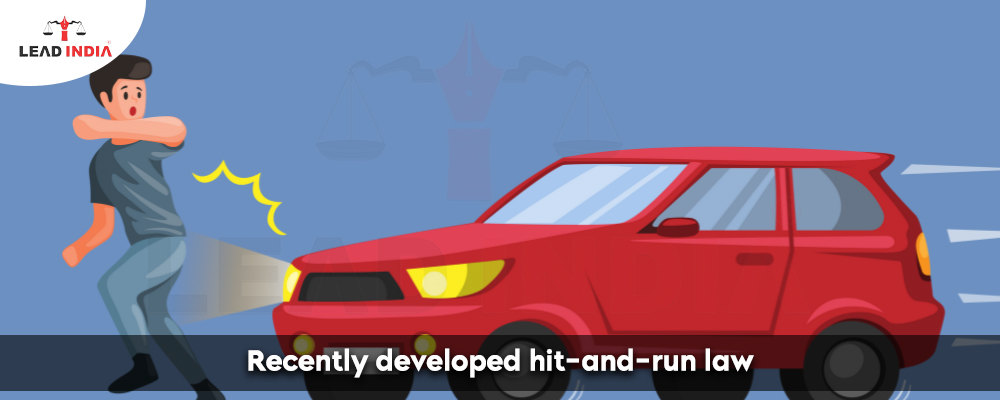Recent demonstrations by transporters and commercial drivers in Maharashtra, Chhattisgarh, West Bengal, and Punjab have put light on the problematic Section 106 (2) of the Bharatiya Nyaya Sanhita, 2023. This clause, which prescribes heavy penalties for hit-and-run occurrences, has been a focal point of anger in the driving community.
What is the Hit-and-Run Law?
Provisions
The hit-and-run clause is part of the Bharatiya Nyaya Sanhita (BNS), which will replace the colonial-era Indian Penal Code of 1860.
Section 106 (2) of the BNS, 2023, imposes a punishment of up to ten years in prison and a fine for escaping an accident scene and failing to report the incident to a police officer or judge.
However, if the motorist reports the incident immediately following the accident, they will be charged under Section 106(1) rather than Section 106(2). Section 106(1) provides for a five-year sentence for causing death by any reckless or careless act that does not constitute culpable homicide.
Need A Legal Advice
The internet is not a lawyer and neither are you. Talk to a real lawyer about your legal issue

Need of the new law
The new regulation is necessary in light of India’s alarming traffic accident statistics. In 2022, India had nearly 1.68 lakh road crash fatalities, averaging 462 deaths per day. India saw a 12% increase in road accidents and a 9.4% increase in fatalities, while global road accident mortality fell by 5%. In India, traffic accidents kill 19 people each hour on average, or about one every three and a half minutes.
More than half of vehicle fatalities occurred on national and state highways, which account for less than 5% of the total road network. With only 1% of the world’s automobiles, India accounts for approximately 10% of crash-related deaths and incurs an annual economic loss of 5-7% of its GDP as a result of road crashes.
Challenging Conditions
Drivers believe that the penalty is exorbitant and does not account for their hard work conditions, including lengthy driving hours and hazardous roads. Transporters also say that accidents might be caused by causes beyond the driver’s control, such as poor vision due to fog and fear of mob violence against drivers who stop to help at accident scenes.
- Perceived Unfair Blame: Drivers claim they are unfairly blamed for accidents, regardless of the circumstances.
- Misuse by Authorities: Authorities may misuse the law, potentially harming the transportation industry as a whole.
- Unfair Treatment: Concerns are raised about the fairness of penalties imposed on truck and private car drivers under present regulations.
- Lack of Differentiation: Section 106(2) does not distinguish between hasty and negligent driving, which are two distinct types of offenses with varying degrees of responsibility. They further argue that the provision does not take into account the contributing variables in negligent conduct, such as commuter behavior, road conditions, road lights, and other comparable circumstances that may affect the driver’s culpability.
Way Forward
- Launch extensive conversations with stakeholders, particularly drivers and transport associations, to address issues and gather varied viewpoints. Create a clear and standardized emergency response protocol that emphasizes the need for fast reporting while protecting drivers from potential violence.
- The existing hit-and-run statute, Section 106 (2) of the BNS, makes no distinction between the various types and results of accidents. The law should be divided into different scales based on liabilities, such as death, grave harm, simple harm, or minor injuries, and the punishment should be proportionate to the offense.
- The regulation should specify the reporting method and the evidence needed for drivers to show their innocence or mitigating circumstances.
- Minor injuries in road accidents should not be considered criminal acts, but instead alternative penalties such as community service, license revocation, or required driving retests should be imposed.
- Invest in better road infrastructure, visibility measures, and safety features to help prevent accidents and hit-and-runs.
- Investigate and use successful ideas and best practices from other nations with effective hit-and-run legislation, tailoring them to the Indian environment.
Lead India offers free legal advice and online information, in addition to other legal services. We offer a platform where you can speak with a lawyer and ask legal questions. Lead India’s lawyers can assist you with any legal issues. Lead India offers free online legal help in India. In addition to providing legal advice online, Lead India allows users to ask professionals questions for free.





 Talk to a Lawyer
Talk to a Lawyer